市场资讯及洞察
.jpg)
摘要
IEA 最新月报显示,全球石油需求增速放缓但仍具韧性。尽管库存持续回升,但 OECD 库存整体仍低于五年均值,市场对供应中断高度敏感。OPEC、IEA、EIA 均上调非 OPEC 供应,未来可能出现“松中带紧”的供需结构。原油价格在供应宽松预期与地缘扰动之间反复震荡,波动率下降但敏感度上升。油市表现也可能通过风险偏好外溢至能源板块、商品货币及相关市场。
一、全球原油供需前景:IEA 月报核心要点
国际能源署(IEA)最新原油月报显示,全球石油需求虽较去年降温,但整体依旧保持韧性 [1]。先进经济体消费表现好于预期,有效抵消部分新兴市场的疲弱需求。IEA 预计 2025–2026 年全球石油需求将保持温和增长。然而在供应方面,如果 OPEC+ 维持当前产量政策且需求不出现明显下滑,全球石油市场未来数个季度可能重新进入“边际紧平衡”状态。IEA 同时指出,高油价、全球经济放缓、电动车渗透等因素正在逐步压制需求增速,使油市呈现出“短期紧平衡、长期温和宽松”的结构。
二、多机构观点对比:OPEC、EIA 与 OECD 数据
三大机构对于未来市场平衡的看法存在显著差异,这主要源于对非 OPEC+ 供应增长和需求韧性的不同假设。总体来看,市场普遍认同未来供应将更加充裕,但对于过剩的规模和时间点存在分歧。

图 3:三大机构对 2025-2026 年需求与供应增长的预测对比,显示供应增长普遍超过需求增长,预示市场将进入供应过剩周期。
OPEC 的观点相对乐观。OPEC 预计 2025 年全球石油需求将增长约 130 万桶/日,2026 年略高至 140 万桶/日 [2]。与此同时,OPEC 在最新报告中连续上调非 OPEC 供给预期,并首次将 2026 年市场从“短缺”调整为“小幅过剩”,反映其判断未来供应增长可能快于需求。
EIA 的判断更偏向供应充裕。EIA 上调了美国页岩油产量预测,指出 2025 年美国原油产量将创历史新高。同时,全球供应预期被上调至日均 1.06 亿桶,高于全球消费的 1.041 亿桶,意味着未来库存可能持续累积 [3]。EIA 预期 2025–2026 年库存增加将对油价形成中期压力。
OECD 库存虽然持续回升,但仍低于五年均值。IEA 数据显示,今年全球观测库存前八个月净增约 2 亿桶,但 OECD 商业库存仍比五年均值低约 6700 万桶。整体来看,库存虽然恢复,但仍处历史偏低区间,使油市对供应中断的敏感度依旧很高。
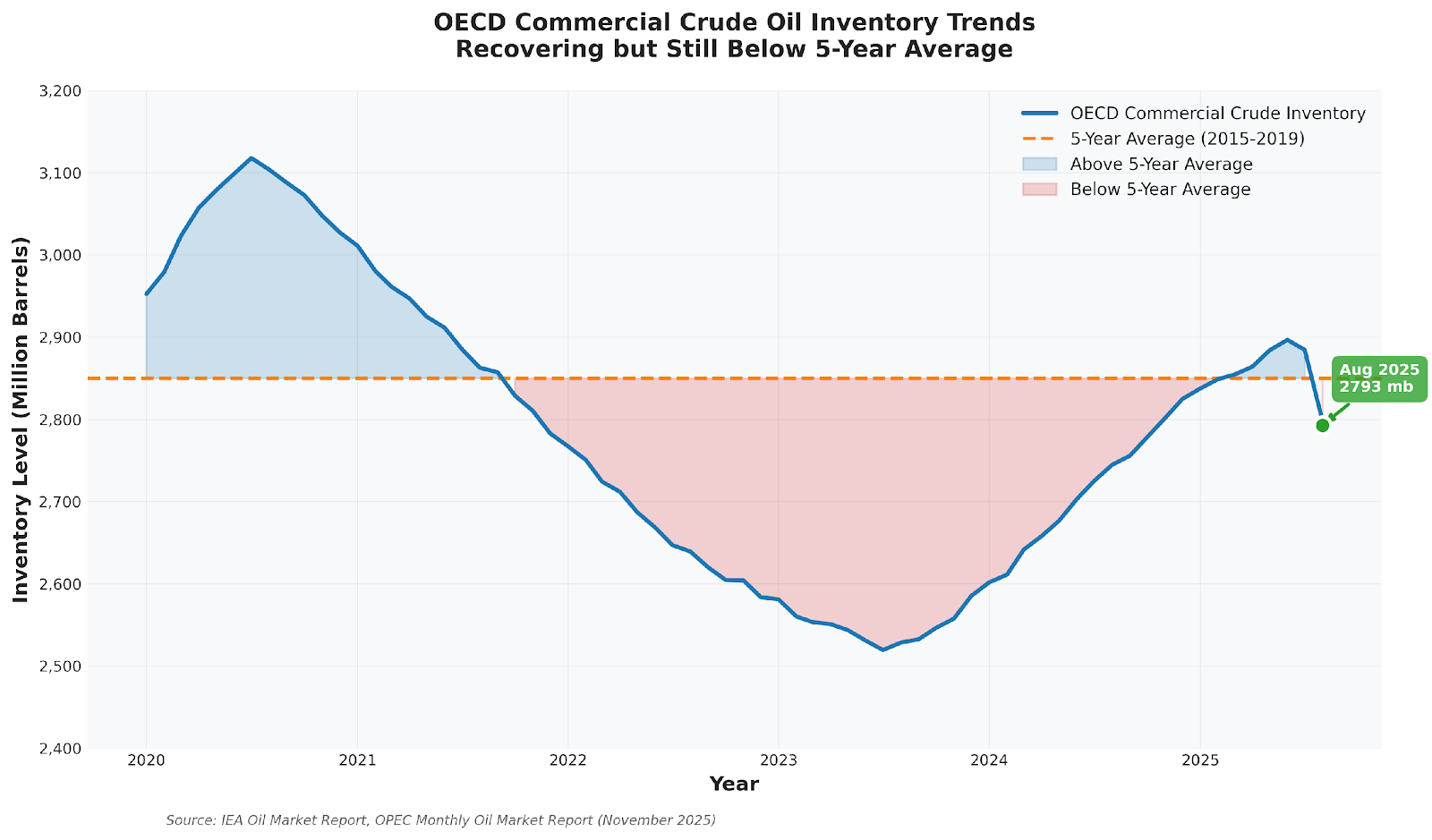
图 1:OECD 商业原油库存近 5 年对比最新水平,显示库存虽有回升但仍低于五年均值。
三、原油价格走势:WTI 与 Brent 如何消化预期
2023 年下半年,布伦特因供应紧张和地缘冲突预期一度突破每桶 90 美元。然而进入 2024–2025 年,随着供应回升和库存恢复,油价整体震荡下移。近期价格承压主要来自供应过剩预期强化以及美国库存意外上升。
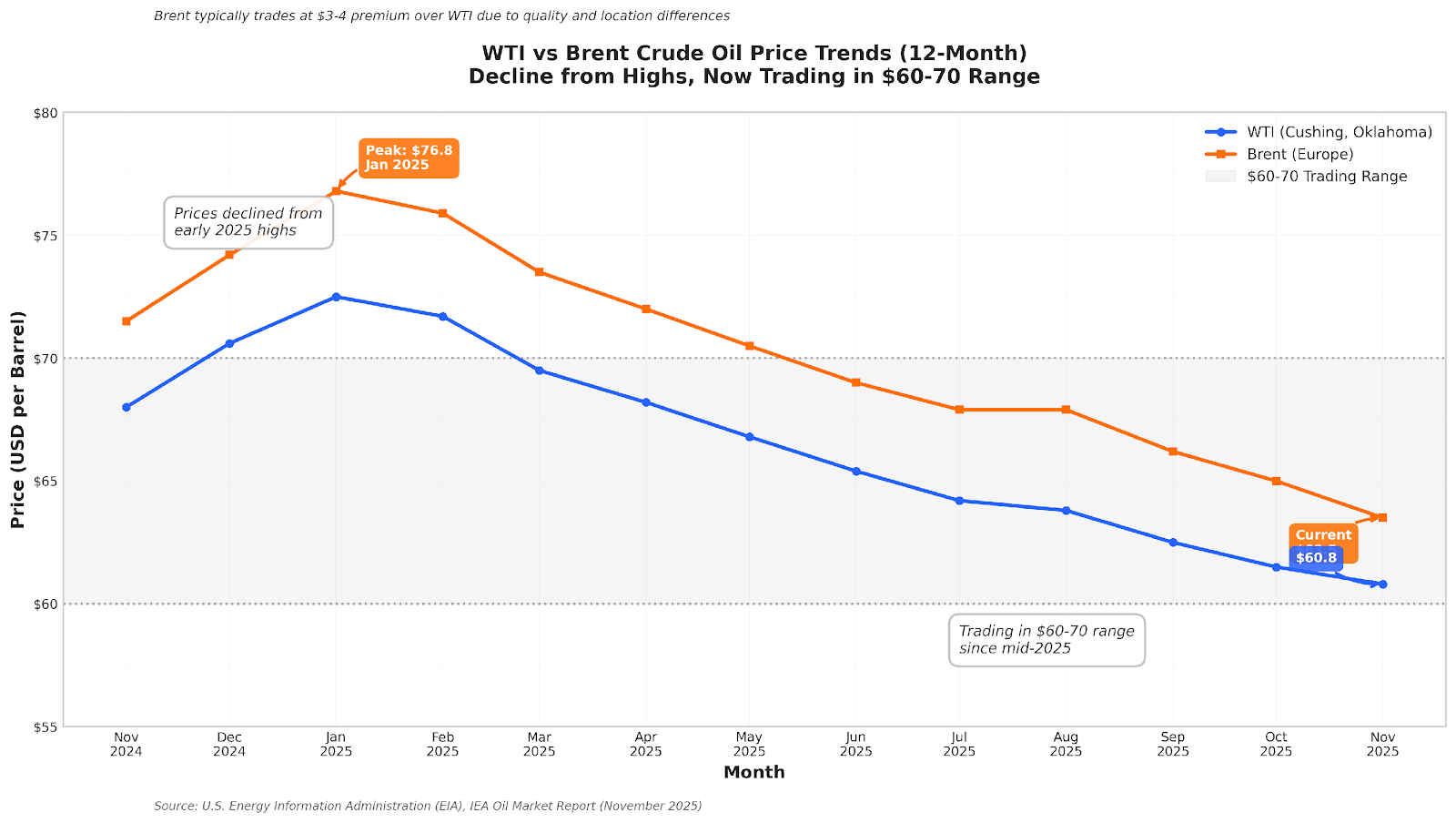
图 2:WTI 与 Brent 价格从 2025 年初的高位回落,近期在 60–70 美元区间震荡。
尽管地缘事件偶尔推升价格,但反弹难以持续,因为供应宽松的结构性预期迅速重新主导市场。WTI 与 Brent 的期限结构一度出现小幅 Contango,显示短期供应充裕压制近端价格,而远月因长期需求预期而保持相对坚挺。整体来看,油市呈现低波动、弱趋势但对消息高度敏感的特征。
四、驱动油市的关键变量:地缘政治与供应端不确定性
运输通道风险仍是油市最大的潜在冲击点之一。全球三分之一海运原油经过霍尔木兹海峡,一旦受阻便可能引发油价剧烈波动。衍生品定价显示断供概率虽低,但属于典型的“低概率、高冲击”事件。
OPEC+ 的政策滞后性也带来结构性波动。减产会压低库存、推高价格,但高油价又刺激非 OPEC 增产,使市场重新宽松。美国页岩油增速放缓进一步加剧供应端的不确定性,削弱其作为“摇摆产能”的角色。此外,俄罗斯、伊朗等国因制裁和冲突导致出口波动,更加剧油市敏感性。
五、油市变化的外溢影响
能源板块通常与油价同方向变动,但反应速度较油价更平缓。油价对风险偏好的溢出效应也容易影响澳元等商品货币。大宗商品价格上行往往提升商品出口国的贸易条件与风险情绪,而价格下跌则可能压制相关货币表现。
六、原油市场风险提示
- 数据发布风险: EIA 每周库存、IEA 与 OPEC 月报可能导致短线波动。
- 地缘政治风险: 产油区冲突、海运通道中断、制裁变化均可能影响供需平衡。
- 宏观风险: 利率政策、美元走势及全球经济增速变化都可能改变需求前景。
结语
IEA 最新展望显示,全球油市进入“边际紧平衡”阶段:库存修复但仍偏低,供应端不确定性大于需求端。在这种结构性环境下,油市会对政策、地缘事件与供给变化表现出高度敏感。理解供需框架、关注库存趋势与识别关键风险,将是未来判断油市走向的关键。
参考资料
[1] IEA (International Energy Agency). (2025, October). Oil Market Report - October 2025. https://www.iea.org/reports/oil-market-report-october-2025
[2] OPEC (Organization of the Petroleum Exporting Countries). (2025, November). Monthly Oil Market Report. https://publications.opec.org/momr
[3] EIA (U.S. Energy Information Administration). (2025, November). Short-Term Energy Outlook. https://www.eia.gov/outlooks/steo/


The Reserve Bank of Australia, (RBA) has surprised much of the market by raising the country's cash rate by just 25 basis points. With analysts expecting a more aggressive 50 bps hike, the smaller lift will provide relief to much of the country's housing market and equity market. RBA, Chairman, Phillip Lowe outlined how previous rate rises had already begun struggling with the previous rate rises.
International volatility has also become much higher with retirement funds in the UK needing to be bailed out by the Bank of England after the funds found themselves inundated with the liquidity issues due to spikes in yield on many of the UK government bonds that they were holding. With the global financial system so interconnected there was a very real chance that a trillion dollars’ worth of bonds would be exposed without intervention effecting far more then just the UK’s financial system. In addition, worries over both Deutsche Bank and Credit Suisse also being in trouble with their risk of defaulting potentially increasing.
This had the RBA worried that the situation could turn very quickly in Australia and sparked the lower rate. With relatively low rates of inflation the RBA has had more flexibility to adjust the aggressiveness of its hikes as it has gone along and todays changes showed that. The bank still expects inflation for the year to be between 6-7 %.
In response to the hikes the AUD dropped sharply on the news falling by 0.52%. Australian equities saw a large jump increasing by 0.93% for the half an hour after the announcement. With inflation still at elevated levels, there is no guarantee that the lower rate hikes will continue.


I have recently written a piece on the weakening of the Great British Pound (GBP) just the other day, as it looks like the dollar seems to be king at present and getting stronger against all other top currencies around the world. Today is the Chinese Yuan in focus, yesterday was the Sterling pound, who’s your money on tomorrow? We will have to wait and see on that front, but lets quickly dive into why is the Chinese Yuan falling to record lows against the dollar?
The offshore yuan depreciated past 7.2 per dollar, sinking to its lowest levels since data on offshore trading became available in 2011, dragged down by a strong dollar amid expectations for more Federal Reserve rate hikes and a widespread risk aversion in the markets. The yuan also weakened despite efforts by authorities to arrest its slide which are so far having limited impact. In the latest developments, the People’s Bank of China raised the foreign exchange risk reserves for financial institutions when purchasing FX through currency forwards to 20% from the current zero starting on Sept. 28th, making it more expensive to bet against the local currency.
A gloomy domestic outlook also weighed on China’s currency, with Nomura and Goldman Sachs slashing their 2023 economic growth forecast for China sharply, predicting Beijing will stick to its strict zero-COVID strategy well into next year. China’s yuan recovered slightly after falling to a 14-year low against the $$$ Wednesday despite central bank efforts to stem the slide after U.S. interest rate hikes prompted traders to convert money into dollars in search of higher returns. At one point, the yuan fell to 7.2301 to the dollar, its lowest level since January 2008.
One yuan was worth about 13.8 cents, down 15% from its March high. As you can see below, the FEDs strategy has reinforced strength in the dollar, a currency that has been rising to records highs, is now contributing to economic pains in various jurisdictions around the world making more expensive for countries such as China, Japan and UK to name a few, to spend more on importing and making their debt even harder to manage, as they also try to keep on top of inflation by raising interest rates which in turn puts off investors who are looking for value in the market; followed by a run on certain currencies as seen with the GBP to bring it to parity (well almost) with the USD. The Dollar Against the World Currencies (As of 16:40 AEST 29/09/2022) There have been ample opportunities to get involved in the FX markets of late, if it’s not buying the dollar, it is to sell other currencies against it, but tread carefully markets are volatile and a sense of trading responsibly must be heeded.
If you would like to study the trends and take advantages of entry opportunities, you can do so by opening an MetaTrader trading CFD account with GO Markets here or find our contact details in the footer below. Sources: fortune.com, tradingeconomics.com


Many trading strategies utilise technical analysis to predict price patterns and for entries and exits. These strategies revolve often begin with the idea of the price having identifiable support, resistance and trendline market structures which indicate where various buying and selling points can be placed for a trade. These support and resistance indicate far more then just the price at a moment in time.
Rather they reflect the psychology of the market at a given point in time. However, when trading it is important to remember that the market is not just made of one type of trader. The market is made up of day traders, swing traders, scalpers, funds, hedge funds, retirement funds, Investment banks and all in between.
Each of these participants has their own time frame for a trade/investment. This element is the key as to why trader can utilise multiple time frame analysis. The theory it that the more market participant who view the respective level as a support or resistance, the more likely it will act in that way.
For example Assume that the price of stock A is sitting on a 5-minute support at $100. Looking purely at this 5-minute chart a trader may look to buy on this support level. However, after looking at the 30-minute chart, the chart shows that the price is not actually a support but rather just a random price point and therefor no trade is entered.
Alternatively, the 30-price chart supports the original price as a support and therefore may support the price point being a support point. How to implement multiple analysis into your trading. Determine your standard trading timeframe.
This step should be a relatively simple step if you have a clear edge. For some traders it can be 5 minutes, 15 minutes, 1 hour, one day or even one week. Work back usually by a factor a factor of 4/5 or by a logical time frame adjustment Prior to your first drawing of support resistance and trendline it is important that you adjust the timeframe of your price chart by a factor of 4/5 or a by logical adjustment such as an hour – to a day or day to week.
Example 5min – 30 min 1 hour – 4 hours 1 hour – day 1 day – 1 week 1 week – 1 month Add in Support and Resistance Lines on longer term time frames The analysis can now start, and the key is to draw the most obvious and consistent support and resistance time frames. This step also serves an important step in helping determine if the price is trending or is ranging. Revert to trading time frame and redo the same process highlighting convergences The next step is to revert to the desired trading time frame and conduct the same process.
This time if there is a Support/resistance line that is already made and acts as one on the shorter timeframe, highlight it or tag it. Looking at the example below for US car making company Tesla, the process is shown on the chart below. Firstly, with the weekly chart, support and resistance points were plotted with the black lines.
The below the daily chart shows that the support point at $265.25 acts as support for both timeframes. This indicates that price may act with more strength as a support zone. Similarly, if the level breaks it may indicate a more powerful move because more market participant will likely be involved.
In the other example for the EURUSD the same process has been done and shows that the price at 0.9600 is also doubling as a support on the daily and weekly charts. The use of multiple time frame analysis can optimise trading systems by reducing risks of fake breakouts and improving entry and exit accuracy.


热门话题
周五美国8月核心物价指数出炉后,数据比预期还差,大大降低了11号9月CPI的乐观预期,美联储11月加息75个基点的概率大增。市场对美国经济衰退的担忧越发严重,多头抛售潮还在继续,道指标普已经破位今年新低,只有纳指还在最低位置挣扎。在这样的行情下,成长股成为首要杀估值对象,很多业绩股也是自身难保,往日的明星板块已经星光不在。

在股市普跌的大环境下,反弹愈发艰难,不知道何时才能出现持续性的反弹,对于熊市的时间估计,目前仅不到之前入熊平均时间的一半,预计还有最少八个月的熊市时间。对于指数下跌空间,目前仅跌去平均熊市回撤的五分之三,三大股指均还有一定幅度的下跌空间。筛选各大板块,当下可以选择的美股代码少之又少,考虑到澳洲矿业出口为主的结构,利用俄乌战争加剧全球能源危机的大背景,加上美国主导遏制油价控制通胀,欧洲主导遏制天然气价格控制物价,传统能源煤炭成了香悖悖。特别是北半球进入下半年,入冬在即,煤炭将是当下必需的资源,由此选出的澳洲煤炭板块中的佼佼者WHC,成为少有的有机会在今年最后三个月依然可以绽放光芒的股票代码。

WHC目前市值81亿,52周从最低$2.12攀升到了$9.33,股息收益率超过5%,市盈率低于5,每股收益接近$2,换手率较低,综合各方面都不失为优秀的持有选择。从公司基本面看,2022年主营业务收入中露天开采占比接近70%,是绝对的主力,地下开采占比近20%。主要客户几乎均在亚洲,其中日本占比超过52%,中国台湾占比近15%,韩国和印度合起来接近20%,印尼占4.4%,其他少许欧洲和澳洲本地市场占比非常低。这还是受到中澳煤炭贸易限制的情况下交出的业绩报表。公司2022年净利润接近20亿,同比增长了458%,因此今年股价也是翻了好几倍。同时负债率降落到了31%,比往年都有所下降。目前现金流超过25亿,是2021年的17倍。从22年财报显示,公司22年总资产收益率37%,资本回报率43%,净资产收益率达到了惊人的56%。从股东持股看,截止8月中,JPMorgan持有超过7%股份占据榜首,其中也不乏Blackrock和Vanguard的身影。

从WHC的技术面看,周线均线排序清晰,趋势一致向上,尽管近期有过短暂大回撤,但长下影线基本消化回撤风险,K线呈强势多头上涨形态,MACD阳柱暴力拉长,目前还在一个强势期,双线差距依旧在加大过程中,并没有出现回落信号。成交量处于十分平稳的状态,就算上周股价的大起大落也没有过多影响成交量的起伏。SAR斜率向上升高,周线显示还在愈发强势过程中,关键指标MA10周线和股价距离不断拉大,保持继续上涨态势。整体上看WHC是少有的今年最后几个月大行情不乐观情况下依然可以逢回落可以进场并且有较大胜算的股票,更是煤炭板块中的明星,是可以短时间看到收益效果的股票,在目前的大环境下优先级别远高于其他原来的明星板块。WHC估值在$11左右,目前处于被低估状态,评级为强力买入级别。免责声明:GO Markets分析师或外部发言人提供的信息基于其独立分析或个人经验。所表达的观点或交易风格仅代表其个人;并不代表GO Markets的观点或立场。联系方式:墨尔本 03 8658 0603悉尼 02 9188 0418中国地区(中文) 400 120 8537中国地区(英文) +248 4 671 903作者:Xavier Zhang | GO Markets 专业分析师
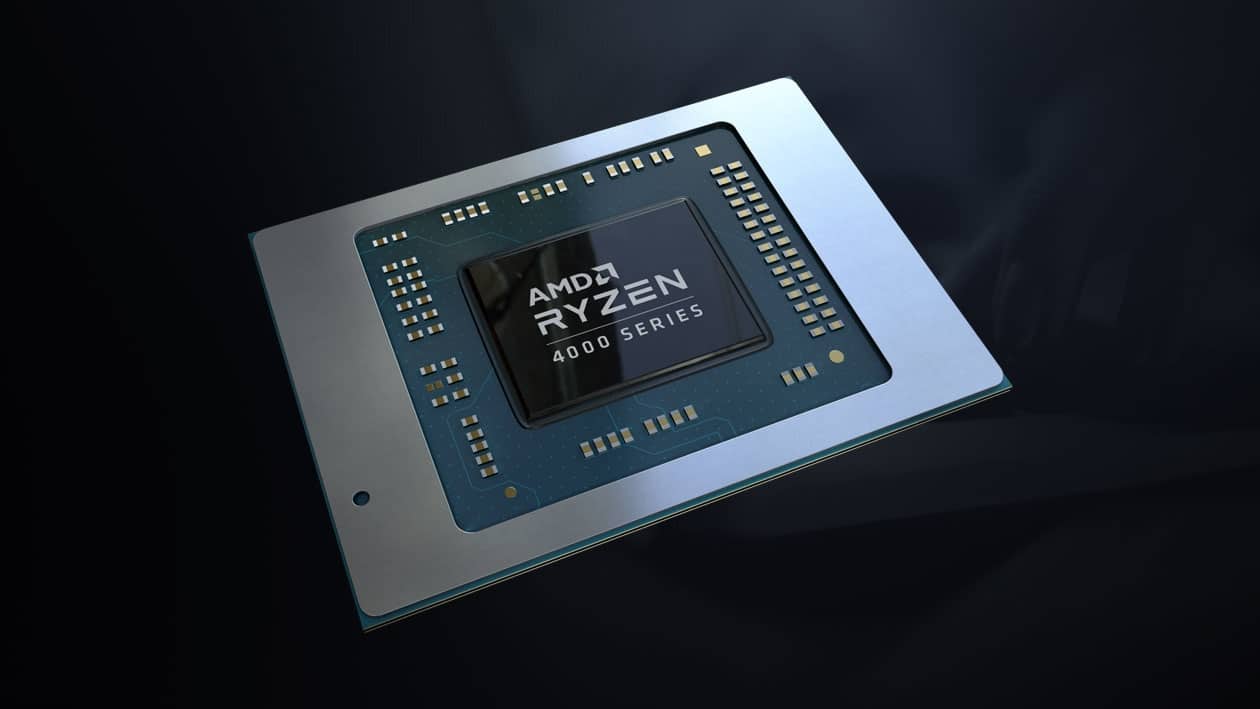

热门话题
AMD 期待了两年的 zen4 架构 Ryzen 7000 系列终于来了。

作为一个经历了红绿争霸(AMD VS NVIDIA)和红蓝之争(AMD VS Intel)的人。从zen2 架构开始,也是见证了AMD的崛起。2019年Zen2 架构的横空出世,让大家看到三代Ryzen 有多么好用。架构层面的突破,随之而来的就是性能的暴增。AMD 一直以来的高性价比策略为其营造了很好的口碑。再加上三代Ryzen 无论是旗舰端,还是中高端,以碾压的姿态打败了9代Intel cpu,也同样的干掉了10代的Intel。继而来到了新一代的Ryzen 5000系列。第四代的锐龙Ryzen 延续了上一代的凶猛势头,在性能上比起上一代提升了xxx,不仅如此,11代Intel 也是被5000系列的CPU完全击败。也正是这两代产品的高调问世,阻止了Intel系列的cpu继续挤牙膏。无论是价格还是性能,大家都在高呼“AMD YES”。因此才有了12代Intel 的超亮眼表现,不过这也是后话了。在两年之后,AMD终于推出了新一代(第五代)的 Ryzen 7000 系列产品。老实说,因为前面两代的提升实在是太巨大了,所以人们对于这代产品期待会有些过高,也有人觉得干不掉12 代 的Intel cpu 就是不合格的。理性点说,12代Intel 可不是前几年挤牙膏的产品,想要这代干翻,可能性其实不大的,我觉得就是比起上一代有不错的进步就够了。那么就来看一看,这一代产品的表现如何。首先看看这一代的改变,这一代的改变第一就是外观上,新一代的外观感觉炫酷了不少,有种蒸汽朋克的感觉。规格上从zen3变为了zen4 架构,工艺从台积电7nm换到了5nm,新的AM5接口。
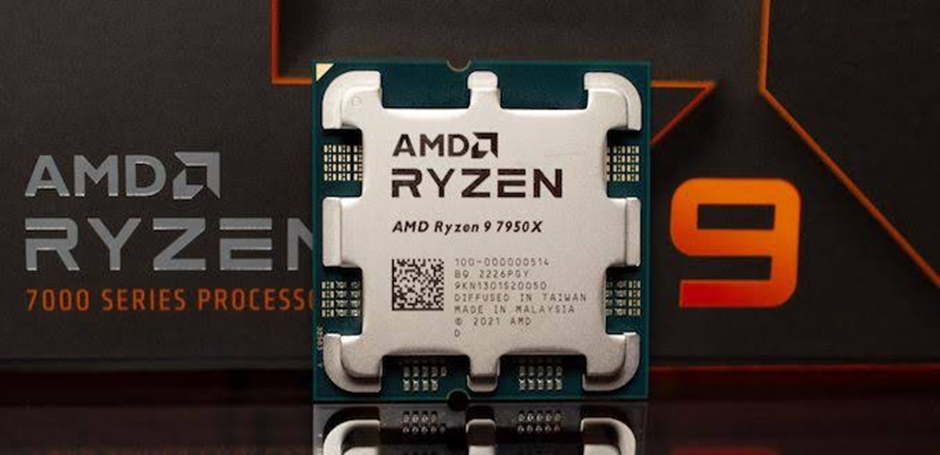
(source:AMD)作为7nm到5nm的工艺改变,那么首当其中的就是可怕的频率,在这代中的7950x频率单核达到了5.7Ghz,全核来到了5.1Ghz。这个数值看的我热血沸腾,想一想上一代5950选材到4.9Ghz,简直像个重磅炸弹,频率是已经追上了Intel 的步伐。值得一提的是,这代7000cpu 中,居然配置了核显了,也就是不买独显,平常办公也够了?这不变相打压一波老黄?接下来就是性能表现了,发布会上AMD宣城的IPC提升是13%,但是我看了下各个测试视频数据,并没有达到那么高。那么这里不得不解释一波,什么事IPC。IPC的英文名称是Instruction Per Clock,中文是每个是每个时钟指令,大致意思就是每个时钟周期下,执行了多少的指令。通常来说,其中CPU性能的公式为性能=IPC*频率。比如说,大家都在4.0Ghz的主频下,IPC提升10,%,也就是CPU性能提升了10%。那么举个例子说明一下,一个工厂进行机械化制作,每次运转可以做10个磨具(IPC),一分钟可以运转5次(频率),那么一分钟就做出来50个磨具(性能)。当工艺改进后,每次运转可以做11个磨具(IPC增加10%),一分钟后做了55个。这样就性能就提高了10%。那么zen2升级到zen3 时候,IPC提升了18%!这么爆炸的提升,隔壁牙膏厂当时想都不要想好吧。因此,在这代Zen4 大家也是给了期待。但是似乎,IPC进步的没想象中那么大?不过呢,这次zen4 架构的高频还是让理论性能比起上代增加了20% 左右。属实效果不错。游戏性能上比起5000系列也有显著提升。不过比起12代酷睿,还是无法打败,这个呢,我相信很多人难免会比较失望吧。其中得提一提,其中上代的5800x3d的游戏性能真是很棒,让我不得不在想,明年会出7800x3d吗?如果有,那么我一定会去入手。Zen4 的创作方面性能,7000系列在专业软件中比起上一代提升挺大,特别是7950x,但是除了7950x,其他的和12代酷睿没有太多优势,考虑到13代酷睿即将发售,不禁也是为AMD捏了把冷汗。

(source:AMD)最后一个就是功耗,发布会上就可看到,其功耗较低了60%, 看了极客湾测评,在同频下,和上代相比,功耗的确是降了60%,性能增加,功耗降低,低碳环保,这点倒是做的很不错,电费也省了不少。总结来说呢,性能比上代提升较大,但是没有完全干掉12代酷睿,相信大家还是会有些失望。因此,在新产品发布之后,AMD的股价并没有太大的上升,因为预期给的足够高,这次新产品并没有达到甚至超过预期。技术面来看,AMD股价已经跌破了区间带70-73下方有着不少的空间。如果AMD股价要回到原来的节奏上,势必需要先突破70-73阻力带。最后,我们也展望一下AMD下一代显卡会不会给我们带来更多的惊喜。
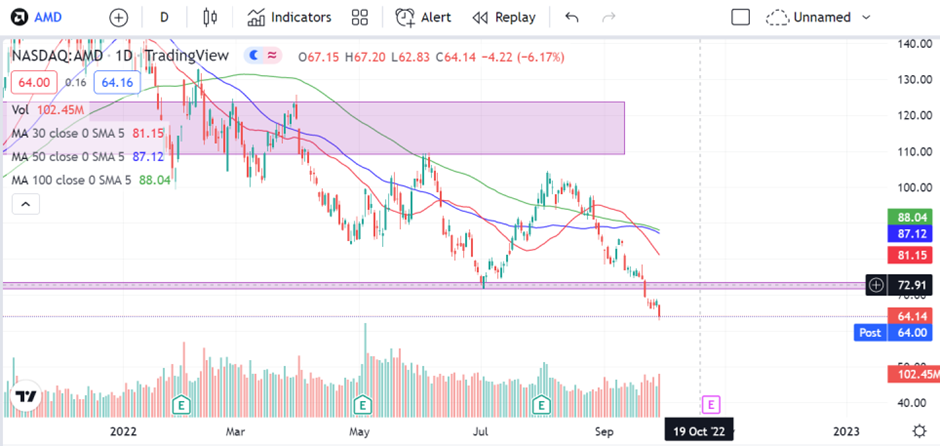
免责声明:GO Markets分析师或外部发言人提供的信息基于其独立分析或个人经验。所表达的观点或交易风格仅代表其个人;并不代表GO Markets的观点或立场。联系方式:墨尔本 03 8658 0603悉尼 02 9188 0418中国地区(中文) 400 120 8537中国地区(英文) +248 4 671 903作者:Neo Yuan | GO Markets 助理分析师
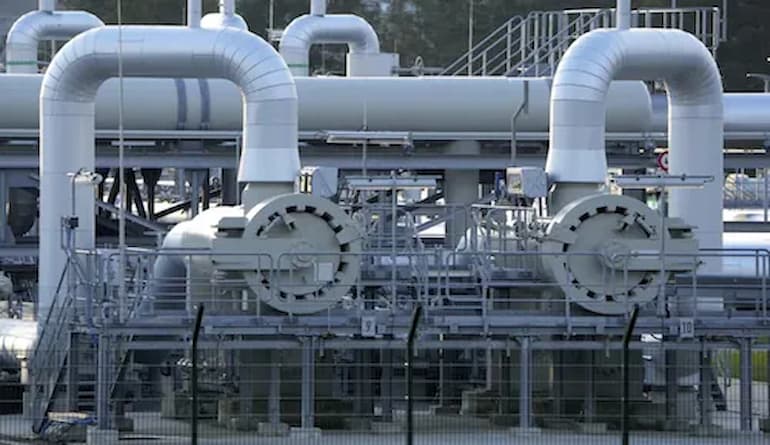

Natural Gas prices have had a volatile year to say the least. After finding multi decade highs on the back of geo-political volatility and record high inflation levels the price has seen an aggressive retracement. With the overall commodities market suffering a big drop as recessionary pressures have taken over and a resilient USD, Natural gas has seen a 30 per cent drop from its peak.
News about leaks in the Nord Stream 1 Pipeline and Russia's control over much of the rest of Europe's supply has seen an increase of volatility and with Europe entering winter soon and the surety of supply still on a knifes edge, the market remains volatile. Looking at the recent price action of Natural Gas, the long-term chart shows that the current price is sitting on a strong area of support at 6 USD. Not only is the price sitting on a strong area of support, the area also doubles as the 200-day average.
The weekly candle is a Doji showing indecision as buyers and sellers look to find the equilibrium price. By comparing both the RSI from the weekly and daily charts its can be observed that there is interesting divergence of patterns. On the weekly timeframe, the RSI is consolidating into a symmetrical triangle whilst the daily RSI shows a bounce off the oversold zone.
This may provide a clue as to which direction the price may go next. If the price continues to bounce off the oversold level, it may indicate a longer-term break on the weekly chart. This bounce would provide an obvious target for a reversal to the long side to the top of the range at 10 USD.
With general market volatility still quite high and commodities seeing aggressive moves, the next 6-12 months may provide some interesting trading opportunities for natural gas in both directions.

